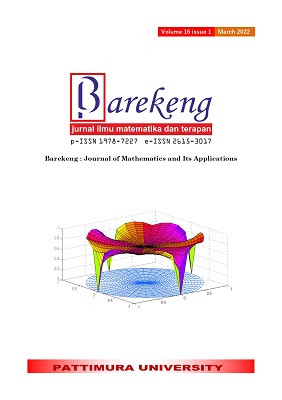WEIGHTED ADDITIVE MODEL AND CHANCE CONSTRAINED TECHNIQUE FOR SOLVING NONSYMMETRICAL STOCHASTIC FUZZY MULTIOBJECTIVE LINEAR PROGRAM
Abstract
The problems of linear programming are developing from time to time, and its complexity is constantly growing. Various problems can be viewed as a multi-objective fuzzy linear programming, multi-objective stochastic linear programming or a combination of both. This research is focused on examining Multi-Objective Fuzzy Stochastic Linear Programming (MOFSLP) with each of the objective functions has a different level of importance to decision makers, or better known as the nonsymmetrical model. The objective function of the linear program contains fuzzy parameters, while the constraint function contains the fuzzy parameters and random variables. The purpose of this study is to develop an algorithm to transform the MOFSLP be a Program of linear Single-Objective Deterministic Linear Programming (SODLP) so that it can be solved using simplex method. In the process of transforming MOFSLP to SODLP, several approaches have been used. They are; weighted additive model, analytic hierarchy process and chance constrained technique. An example of numerical computations has been provided at the end of the discussion in order to illustrate how the algorithm works. The resulted Model and algorithm are expected to help companies in the decision making process.
Downloads
References
F. S. Hillier and G. J. Lieberman, Introduction to Operations Research, 11th ed. New York: McGraw-Hill Education, 2021.
F. M. Zenis, M. Y. Fajar, D. Y. Ramdani, and Y. Ramdani, “Program linear multi-objective dengan fixed-weight method,” Jurnal Matematika, vol. 14, no. 1, pp. 1-7, May 2015.
G. S. Mada, “Model pembobotan aditif termodifikasi untuk menyelesaikan masalah pemilihan supplier multi-objektif fuzzy dengan fungsi objektif fuzzy dan kendala fuzzy pada rantai supply,” ["A modified additive weighting model to solve a fuzzy multi-objective supplier selection problem with a fuzzy objective function and fuzzy constraints on the supply chain,"] Prosiding Seminar Nasional Saintek IV FST Undana, pp. 87-98, Oct. 2019.
H. Nasseri, M. Morteznia, and M. Mirmohseni, “A New Method for Solving Fully Fuzzy Multi Objective Supplier Selection Problem,” Int. J. Res. Ind. Eng, vol. 6, no. 3, Nov. 2017.
H. Cheng, W. Huang, Q. Zhou, and J. Cai, “Solving fuzzy multi-objective linear programming problems using deviation degree measures and weighted max–min method,” Applied Mathematical Modelling, vol. 37, no. 10, pp. 6855–6869, Jun. 2013.
H. Suprajitno, “Solving Multiobjective Linear Programming Problem Using Interval Arithmetic,” Applied Mathematical Sciences, vol. 6, no. 80, pp. 3959-3968, 2012.
H. M. Nehi and M. Alineghad, “Solving Interval and Fuzzy Multi Objective Linear Programming Problem by Necessarily Efficiency Points,” International Mathematical Forum 3, pp. 99-106, 2008.
A. E. Munthafa and H. Mubarok, “Penerapan metode analytical hierarchy process dalam sistem pendukung keputusan penentuan mahasiswa berprestasi,” ["The application of the analytical hierarchy process method in the decision support system for determining outstanding students,"] Jurnal Siliwangi Seri Sains dan Teknologi, vol. 3, no. 2, pp. 192–201, 2017.
P. T. Prasetyaningrum and A. Sari, “Penerapan analytical hierarchy process (AHP) untuk mendukung keputusan pemilihan desrinasi tempat wisata daerah istimewa yogyakarta untuk para wisatawan mancanegara non asia,” ["Implementation of the analytical hierarchy process (AHP) to support the decision to choose tourist destinations for the Yogyakarta Special Region for non-Asian foreign tourists,"] Jurnal SIMETRIS, vol. 10, no. 2, pp. 519-528, Nov. 2019.
S. Hulsurkar, M. P. Biswal, and S. B. Sinha, “Fuzzy programming approach to multi-objective stochastic linear programming problems,” Fuzzy Sets and Systems, vol. 88, no. 2, pp. 173–181, Jun. 1997.
M. Sakawa, I. Nishizaki, and H. Katagiri, Fuzzy Stochastic Multiobjective Programming, New York: Springer New York, 2011.
D. A. Kalaichelvi and K. Janofer, “α-cuts of triangular fuzzy numbers and α-cuts of triangular fuzzy number matrices,” Int. Jr. of Mathematic Science & Applications, vol.2 no.2, pp. 635-643, May 2012.
B. T. Balan, “Solving Multi-Objective Fuzzy Linear Optimization Problem Using Fuzzy Programming Technique,” IOSR Journal of Mathematics, pp. 18-21. 2016
Y. Septiani, B. Irawanto, and S. Hariyanto, “Program linier fuzzy penuh dengan algoritma multi objective linear programming menggunakan metode level sum,” ["Full fuzzy linear program with multi objective linear programming algorithm using level sum method,"] Jurnal Mahasiswa Matematika Undip, vol. 5, no. 4, pp. 1-10, 2016.
E. Lalian, G. S. Mada, F. Luan, and E. Binsasi, “Pengembangan Program Linear Multi-Objektif Fuzzy Stokastik Model Simetris dan Penyelesaiannya dengan Menggunakan Teknik Chance Constrained,” ["Development of a Symmetrical Fuzzy Stochastic Multi-Objective Linear Program and its Solution using the Chance Constrained Technique,"] Jurnal Sains Lahan Kering, vol. 4, no. 2, pp. 22–24, Jan. 2022.
Authors who publish with this Journal agree to the following terms:
- Author retain copyright and grant the journal right of first publication with the work simultaneously licensed under a creative commons attribution license that allow others to share the work within an acknowledgement of the work’s authorship and initial publication of this journal.
- Authors are able to enter into separate, additional contractual arrangement for the non-exclusive distribution of the journal’s published version of the work (e.g. acknowledgement of its initial publication in this journal).
- Authors are permitted and encouraged to post their work online (e.g. in institutional repositories or on their websites) prior to and during the submission process, as it can lead to productive exchanges, as well as earlier and greater citation of published works.






1.gif)



